">Bronze Casting - Ceramic Shell Dip

Bronze casting is a complicated process. Once you get a wax model prepared - usually cast from a mold taken of a clay sculpture - you mount the wax model on a cup (nowadays it's a run of the mill disposable paper cup). The attachment is made via a wax "sprue" - a (usually) square bar of wax a few inches long and about an inch across. You then must attach wax rods in just the right places to provide vents so the wax can flow freely throughout the mold and allow air and hot gases to escape.
Once the wax model is prepared, you start a rather long process where you dip the model in a specially formulated colloidal silica suspension (the formula is rather exacting and will not be discussed in detail here). This is a picture of the first dip.
Once dipped and excess liquid drained, you check to make sure the suspension is coating all the surface. You then roll the model in a fine sand which adheres to the model and forms an outer coating of the sand. Then you let the dip/sand layer dry, typically for 2 1/2 to 3 hours. In foundries, the drying is done on racks with fans blowing over the models. That, mind you, is the first dip. In the end you repeat the dipping process - but with some variations - about ten times.
The dips are done using increasingly coarse sand, the exact fineness and procedure dictated by the size and complexity of the art. Commonly you have four grades of sand from very fine to "kitty litter" grade. Usually you have at least two dips per grade. But you don't have to use all grades in all circumstances. This model was fairly simple and didn't require particularly coarse sand at the later dips. Large statues have the coarsest grade of sand on the outer layers to add extra strength.
After the fifth dip, you then wrap the shell with thin but strong steel wire, not entirely like a cocoon but just enough to provide additional support to the shell. The wire wrapping is done because the shells might crack when contacted with the hot bronze (typically poured at over 2000 degrees Fahrenheit). If held together with wire, the shell stays sufficiently together even if cracked. But without wire a cracked shell would fall apart, and your bronze cast would be ruined.
After the wrap with wire, you continue the dipping and rolling four more times, letting each layer dry as before. Then you make a final dip without sand to produce a fairly smooth, non-crumbly outer layer, and let the shell dry one last time. You are ready to burn out the wax which requires, of course, special facilities, equipment, and training. But in the end you are left with a hollow mold of hard ceramic material with a nice cup in which to pour your bronze.